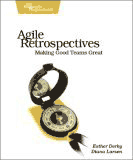
Perfectly fitting with the style of the Pragmatic Programmer series, Agile Retrospectives: Making Good Teams Great is a book for helping teams run effective and fun retrospectives.
Whether you call them postmortem, postpartum, or retrospective meetings; these meetings can help your team iteratively move forward by looking back.
After reading the first few chapters of this book in Barnes and Noble, I committed to buying this book under the pretense it would speak more generally about why teams should hold retrospectives and how to incorporate needed changes back into the process. Upon further reading, this is not at all what this book is about. This book is about providing concrete activities to get your team communicating.
Activities are included for gathering data, insights, and next iteration/project goals. For example, at Sundog we have used a permutation of the Mad, Sad, Glad activity. The activity is simple, draw on a white board three areas labeled Mad, Sad, Glad. You are given (at minimum) 5 post-it notes and are required to fill them out with things that made you…well mad, sad, or glad. When everyone is finished filling out their post-it notes, in round-robin fashion, post-it notes are placed on the appropriate area. Each note is allowed a maximum of 5 minutes of discussion.
If Mad, Sad, Glad seems to simple to be effective, just answer the question – Have I ever been in a meeting where only one person speaks? If you haven’t, consider yourself lucky. Many retrospectives are not effective as they are hijacked by individuals who tend to be heavily opinionated (primarily negatively charged as well). Simple activities outlined in Agile Retrospectives allows for equal participation and distributed opinions.
Chapter List
- Helping Your Team Inspect and Adapt
- A Retrospective Custom-Fit to Your Team
- Leading Retrospectives
- Activities to Set the Stage
- Activities to Generate Insights
- Activities to Decide What to Do
- Activities to Close the Retrospectives
- Releases and Project Retrospectives
- Make It So
The Good
- Teaches methods for managing group dynamics
- Full of activities to increase communication
- New ideas for generating insights
- Easy to read in quick bite-size sprints
The Bad
- Includes activities for post-retrospective goal setting, but neglects to give ideas for achieving/enforcing them
- Very thin on outlining why we have retrospectives (40 pages)
- A few activities are better suited for elementary children than adults
- Should have been renamed – The Ultimate Retrospective Activity Handbook
Every team can find this book a great resource as it is chalked full of new ideas for keeping your retrospectives fresh and on topic. If you are still not convinced, the authors did a recorded Google TechTalk which can give you a good feel for the book.
 Agile Retrospectives: Making Good Teams Great
Agile Retrospectives: Making Good Teams Great
Notice: All reviews on codesqueeze are not paid nor are traded for services. These reviews are shared so you may save time in your quest for better tools.




